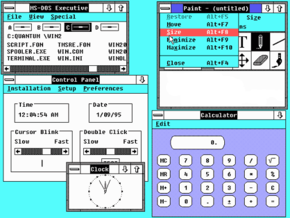- Windows 2.0
-
Windows 2.0 Part of the Microsoft Windows family 

Screenshot of Windows 2.0 Developer Microsoft Website http://www.microsoft.com/ Releases Release date December 9, 1987[info] Current version 2.03 (1988)[info] Source model Closed source License MS-EULA Preceded by Windows 1.0 Succeeded by Windows 2.1x Support status Unsupported as of December 31, 2001 Windows 2.0 is a 16-bit Microsoft Windows GUI-based operating environment that was released on December 9, 1987 [1] and is the successor to Windows 1.0. With Windows 2.1x in 1988, Windows 2.0 was supplemented by Windows/286 and Windows/386. Windows 2.0, Windows/286 and Windows/386 were superseded by Windows 3.0 in May 1990, but supported by Microsoft for fourteen years until December 31, 2001.
Contents
History
Application support
The first Windows versions of Microsoft Word and Microsoft Excel ran on Windows 2.0. Third-party developer support for Windows increased substantially with this version (some shipped the Windows Runtime software with their applications, for customers who had not purchased the full version of Windows). However, most developers still maintained DOS versions of their applications, as Windows users were still a distinct minority of their market.
There were some applications that shipped with Windows 2.0. They are:
- CALC.EXE
- CALENDAR.EXE
- CARDFILE.EXE
- CLIPBRD.EXE
- CLOCK.EXE
- CONTROL.EXE
- CVTPAINT.EXE
- MSDOS.EXE
- NOTEPAD.EXE
- PAINT.EXE
- PIFEDIT.EXE
- REVERSI.EXE
- SPOOLER.EXE
- TERMINAL.EXE
- WRITE.EXE
Legal conflict with Apple
Main article: Apple v. MicrosoftOn March 17, 1988, Apple filed a lawsuit against Microsoft and Hewlett-Packard, accusing them of violating copyrights Apple held on the Macintosh System Software[2]. Apple claimed the "look and feel" of the Macintosh operating system, taken as a whole, was protected by copyright and that Windows 2.0 violated this copyright by having the same icons.
Features
Windows 2.0 allowed application windows to overlap each other unlike its predecessor Windows 1.0, which could display only tiled windows. Windows 2.0 also introduced more sophisticated keyboard-shortcuts and the terminology of "Minimize" and "Maximize", as opposed to "Iconize" and "Zoom" in Windows 1.0.
References
- ^ http://windows.microsoft.com/en-US/windows/history
- ^ "1980 - 1989: An Industrial Milestone". The Apple Museum. http://www.theapplemuseum.com/index.php?id=56. Retrieved September 4, 2009.
External links
- GUIdebook: Windows 2.0 Gallery – A website dedicated to preserving and showcasing Graphical User Interfaces
- ComputerHope.com: Microsoft Windows history
- Microsoft article with details about the different versions of Windows
Microsoft Windows family DOS-Based Windows 9x Windows NT Early versions[α]Client releasesWindows XP (editions [x64 · Media Center] · development) · Windows Vista (editions · development) · Windows 7 (editions · development) · Windows 8Server 2003 · Server 2008 (Server 2008 R2 · HPC Server 2008 · EBS 2008) · Home Server (Home Server 2011) · MultiPoint Server · Small Business ServerSpecializedWindows Embedded (Automotive · POSReady) · Windows Preinstallation Environment · Windows To Go · Windows Fundamentals for Legacy PCsWindows CE Mobile Windows Mobile · Windows PhoneCancelled Related topics Notes:
- ^ These operating systems have both client and server editions.
Categories:- 1987 software
- Discontinued versions of Microsoft Windows
Wikimedia Foundation. 2010.
